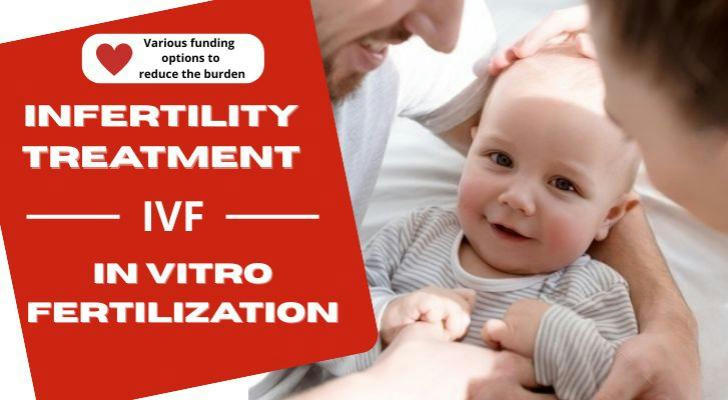IVF Explained: Costs, Success Rates, and How to Get Financial Help
Infertility puts a lot of pressure on many families, but in vitro fertilization (IVF) brings hope to realize the dream of having a child. Regardless of the cause, IVF may help realize the desire to become a parent. This article will briefly describe its process, cost, success rate, and real-life success stories.

👨👩👦 Understanding Infertility: It Affects More People Than You Think
Infertility is the inability to conceive after one year of trying to conceive (six months for women over 35) without any protection. Infertility affects both men and women, and its causes are generally classified into the following categories:
• Female Infertility (40%) – This includes conditions such as ovulation problems, blocked fallopian tubes, endometriosis, or decreased egg quality due to aging.
• Male Infertility (40%) – This includes factors such as low sperm count, low sperm motility, or abnormal sperm.
• Unexplained Infertility (20%) – In some cases, no clear cause can be found, which can make the situation even more frustrating for couples.
Despite these challenges, modern treatments such as in vitro fertilization (IVF) can overcome infertility, offering a ray of hope to those facing this dilemma. 💟
🧬 What is IVF? Overview of the Process
IVF is a treatment that involves fertilizing eggs outside the body and implanting them in the uterus. IVF offers many couples the opportunity to have a child when other methods have not worked.
👩🏫 IVF Process Breakdown:
1. Ovarian Stimulation – Hormone injections help the ovaries produce multiple eggs.
2. Egg Retrieval – A minor surgery is performed to retrieve the eggs.
3. Sperm Collection and Fertilization – Eggs and sperm are combined in the lab to form embryos.
4. Embryo Culture – The healthiest embryos are selected for transfer.
5. Embryo Transfer – The embryos are transferred to the uterus.
6. Pregnancy Test – A blood test is done two weeks after the transfer to confirm the pregnancy
🎉 Success Rate:
Women under 35 – Success rate is around 55% per cycle.
Women aged 35-40 – Success rate is around 35% per cycle.
Women aged 40+ – Success rate is around 20% or less per cycle.
Medical advances are improving IVF success rates, giving many couples a better chance of success.
💰 How to reduce the financial pressure of IVF?
The cost of IVF is often prohibitive for many families, with a single treatment usually ranging from $12,000 to $25,000, and sometimes multiple attempts are required. But the good news is that there are many ways to ease the financial burden, and here are a few ways worth exploring:
🌟 Funding and support channels available:
• Nonprofit funding: Organizations like Baby Quest, Cade Foundation, and Gift of Parenthood provide funding ranging from thousands to $10,000 each year, covering IVF, egg or sperm donation, and even surrogacy services.
• Cancer Patient Support: LIVESTRONG Fertility and Team Maggie for a Cure offer cancer patients support by providing egg/sperm freezing subsidies prior to treatment, as well as partial funding for future IVF.
• State and Military Benefits: Some states (e.g., Massachusetts, Illinois) have passed laws requiring insurance companies to cover fertility treatments. Veterans and their families may also receive support through VA (Department of Veterans Affairs) or TRICARE (military insurance).
🏥 Clinic-Level Subsidy Programs:
• Clinic Discounts and Payment Plans: Many fertility clinics offer flexible payment options, including installment plans, low-cost IVF cycles or trial packages, for patients with certain conditions.
• Internal Funding Programs: Some clinics have funds or scholarships to help eligible families with financial difficulties complete IVF treatment.
💬 Real Stories
Stories from IVF families show the power of the journey.
• Emily and James from North Carolina tried for years to get pregnant. With a $10,000 grant from the Cade Foundation, they finally conceived through IVF—and after years of heartbreak, they finally had a child of their own. “It wasn’t just financial help,” Emily shared, “it gave us a future.”
• Maria, a breast cancer survivor, froze her eggs before starting chemotherapy. Years later, she reused her frozen eggs and gave birth to a healthy daughter. “I thought cancer was going to take everything from me,” she says, “but it brought me here.”
• Lisa is a single woman in her 40s who started her own family through IVF. Her story is an inspiration to others who are considering single motherhood.
🌈 You are not alone in this journey
The road to infertility is not easy. The high costs, long waits, and repeated emotional fluctuations often make people feel exhausted. But remember that you are not alone on this road. Whether it is medical resources, financial support, or psychological companionship, there are many channels to help you.
If you are considering in vitro fertilization (IVF), you can start from the following aspects: talk to a fertility specialist first to understand your physical condition and treatment options; check your state's insurance policy to see if fertility treatment is covered; pay attention to non-profit organizations such as Baby Quest and Cade Foundation, which provide funding applications all year round; join offline or online support groups to meet people who are going through similar stories.
Every small step is a step closer to hope. Even if the road seems long, there is still light at the end.
📌 Next steps:
💡 Find IVF funding programs like Baby Quest or Cade Foundation
** 🏛 Understand your state's insurance policies for fertility treatment**
👩⚕️ Talk to your doctor about IVF options
** 💬 Join an infertility support community for emotional support and practical advice**
👶 IVF technology has helped more than 8 million new lives around the world—you may be the next lucky family.
